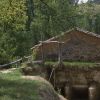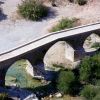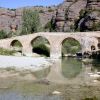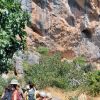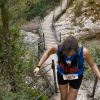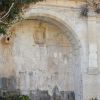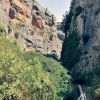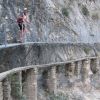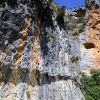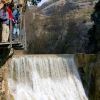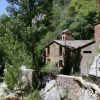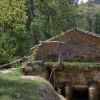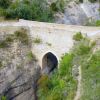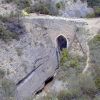Patrimonio Hidráulico
Fuendebaños bridge. Alquézar

With its many rivers and a population scattered across small nucleuses, Somontano is criss-crossed with a multitude of paths, many of which cover dangerous and steep terrain. Although the rivers formed an obstacle to communication in the past, it was not common to build bridges from stone. It was much more usual to make wooden structures or, where possible, simply place a large trunk across the water.
Stone bridges were a luxury that required great investment. Only kings or rich and powerful people could afford the construction expenses. In addition, it was also necessary to have master bridge builders present, specialists who where experienced in their trade. Because of all this, the construction of a bridge was only undertaken in rivers with a strong flow or in areas of great unevenness.
In the environs of Alquézar there were at least three bridges; Fuendebaños, Albarda and Villacantal, which highlights its importance as a vital crossroads.
The name Fuendebaños is related to the spring situated downstream. Its waters flow from the ground at a constant temperature so giving a sensation of warmth, even in winter. In many medieval documents it is recorded as Fontes Caldos (warm fount.) “It carries particles of sulphur, iron and nitrogen and contributes very effectively to the cure of illnesses…can be extracted for various medical purposes…for sick people in and out of the village.”
P. Madoz. Statistical Geographical Dictionary. 1846.
This bridge is also known as the Asque Bridge because the footpath on the left bank goes up river to Colungo and Naval.
The presence of a bridge in this area is directly related to the nearby mill as access to it with horses laden down with cereals required some measure of safety when the river was swollen. The water of the River Vero can rise suddenly and uncontrollably.
The bridge is made up of three semicircular arches with the central one being the largest. The arch to the left is actually the smallest and often acts as a spillway. It has two terraced breakwaters to minimise surges of water and its deck is pitched. Due to the constant repairs necessary over different eras, the marks of the wooden falsework used in construction can still been seen today.
Canyon fountain. Alquézar
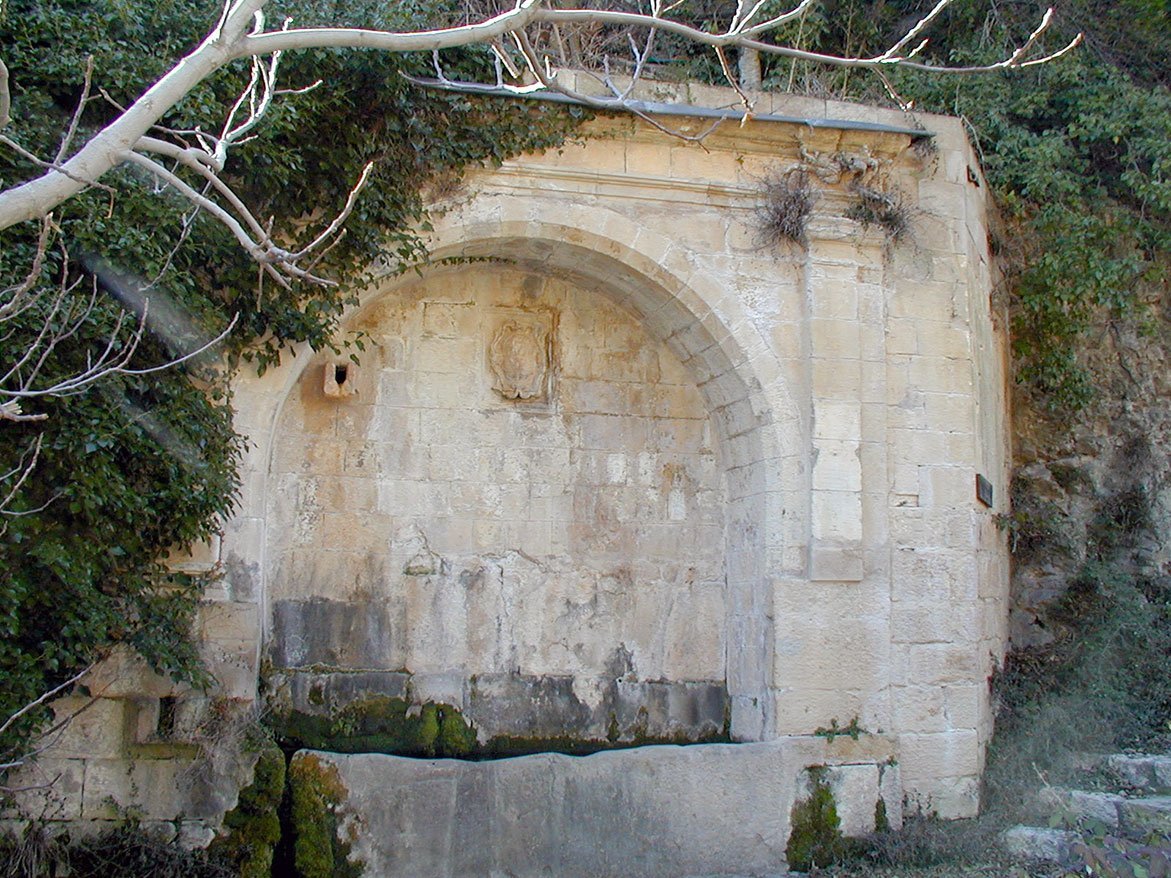
A footpath leaves from the Calle de la Iglesia and descends the narrow gorge know as the La Fuente Canyon down to the river. It takes its name from the pretty Renaissance bridge that was constructed in the 16th century, which boasts an impressive view of the rocky cliffs that rise up to the collegiate church.
The public fountain, which was almost always located out of the village, was the urban element that received most attention from the municipal council. Its construction was a priority as soon as other basic needs had been covered, and was even deemed more important than the council building. On occasion, master fountain makers or sculptors were employed, or, as is the case here, a master stone mason was contracted. There is no doubting his skill or his knowledge of the classical tastes of the times.
Although the composition is fairly simple, Alquézar’s fountain was grander than the majority of those built in Somontano in that era, being more detailed in design and reflecting greater care in its construction.
The municipal crest that adorns the fountain indicates who financed the work and in which year.
There is a cross carved into one of the ashlars. It was common to find marks of this nature as they were believed to protect of all type of spring, well and fountain.
Dams, mills, channels and an old electric plant. Alquézar

The River Vero flows underground for a long stretch until emerging in Lecina and from here if runs its course through spectacular canyons and narrow gorges.
Cave art close to Lecina and Alquézar is testimony to the activity of man in this remote area as far back as the pre-historic era. Durant Islamic rule, the Vero acted as a natural communication route between Al-Qsar (Alquézar or fortress) and the Moorish city of Barbastro, capital of the Barbitanya region. Later, the river became a natural corridor for the penetration of Aragonese troops in their advance from Sobrarbe to conquest the flatter land to the south.
Despite the narrow water flow as it passes by Alquézar, the Vero’s waters have been used for the maximum benefit of man in the past. The mills, dams and bridges that remain are evidence of the intense activity that took place here until recently.
A dam is a barrier that raises the level of the water in order to direct it to a channel to be used as a hydraulic force or to water land. The dam at Alquézar dates back to medieval times and the water held here was channelled to an old mill that no longer exists. Around 1909 the dam was reinforced with cement and a new channel was built, which can still be seen today. This took the water to the turbines of a small electricity plant that had been installed on the site of an old mill.
Travelling down the river, the sheer, calcareous walls give way to more rounded conglomerate rock faces. Beneath these cliffs there is another dam, which was originally used to collect water for the paddles of an ancient fulling mill. The purpose of this mill was to transform open weave cloths into more closely woven fabric. The force of the water moved a wheel that drove mallets, which would beat the cloth to make it more compact. Records date the fulling mill of Alquézar back to the year 1190. Taking into consideration that this type of machine did not emerge until the 12th century, this incipient pre-industrial activity brought great prosperity to the village of Alquézar in the medieval era.
Later, between the 14th and 15th centuries, the dam was put to use to serve a flour mill situated 200 metres downstream. The water from the dam was channelled to a small reservoir and in this way the miller was guaranteed production without being subject to the variable fluctuations of the river flow. The water was fired with great force down to the mill through chutes to drive the millstone and poured out from a space below. These cavities are the only constructive element to differentiate the mill from an old country house.
Devil´s Bridge. Asque
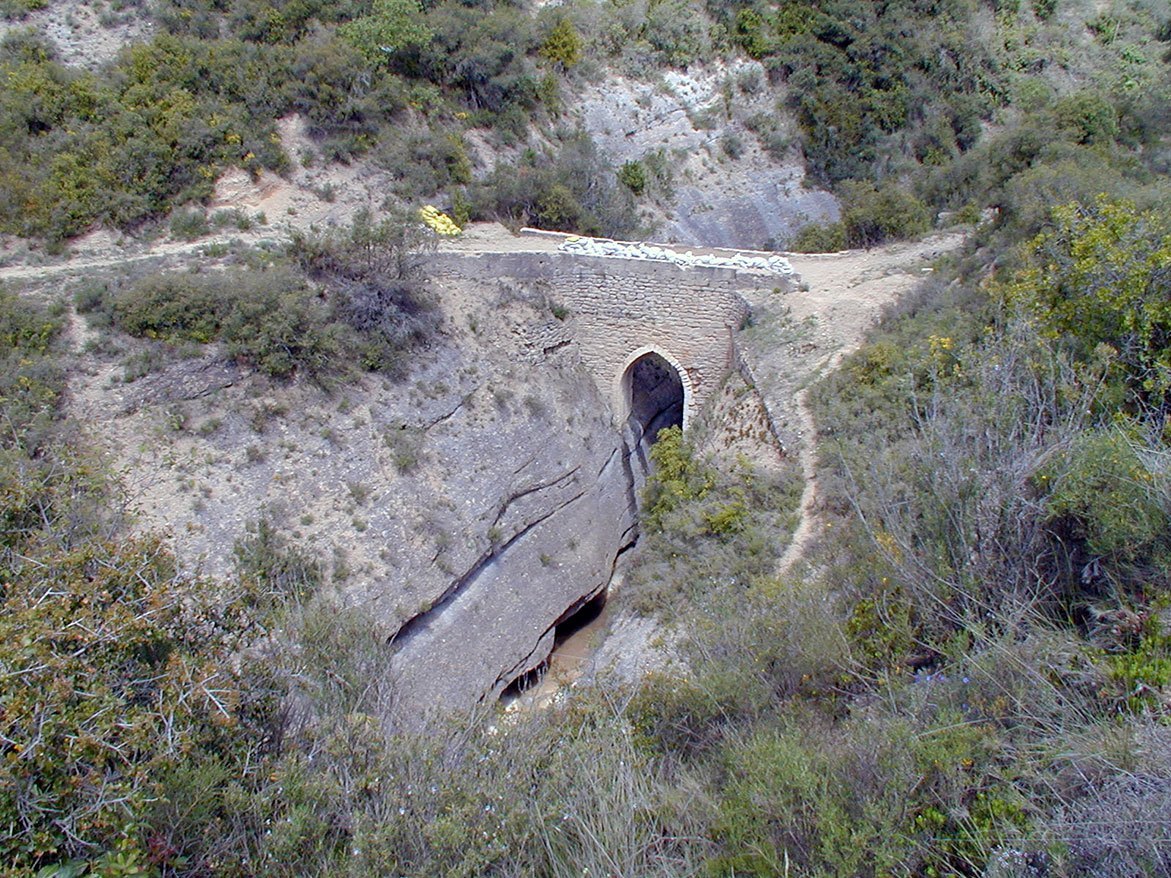
With foundations anchoring it to both sides of the Fornocal canyon, this bridge was built to connect the villages of Asque and Colungo. Its spectacular location highlights the risks and difficulties associated with its construction, and because of this many legends attribute it to the work of the Devil. However others explain that the name, “The Devil’s Bridge,” makes reference to the fact that the Devil passed over it while the mortar was still fresh and left his footprint to finish off the work. The footprint in question does not belong to a dog, deer or wild boar, so it must have been left by the devil. The question is, was he on his way from Colungo to Asque or Asque to Colungo?
The bridge is probably medieval in origin. Its deck is flat, almost 3 metres wide, and rests on a lancet arch made with small, perfectly made voussoirs. The rest of the construction is masonry. The pointed arch was a later addition as there are still remains of an older, semicircular arch. The unusual distance between the bridge’s parapet and the arch is explained by the fact that the facings have been renovated on several occasions.
Spring brings the arrival of a blanket of spectacular flowery stems that reach as high as 60 cm tall on the calcareous, conglomerate walls of the canyon. These flowers are known as the King’s Crown, Saxifraga longifolia, whose base rosette of leaves that give rise to the stem dies soon after flowering.


